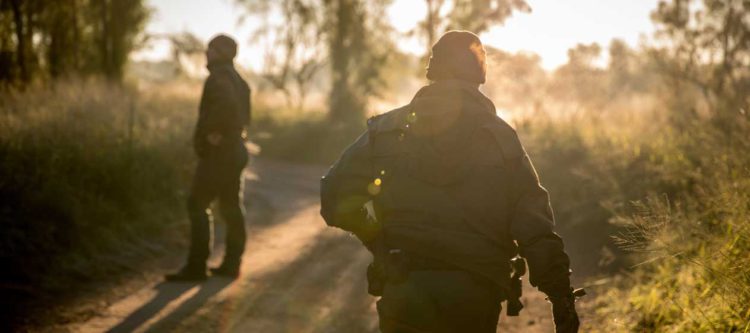3 topics dominating discussion at the 2023 Border Security Expo

Earlier this month, I had the opportunity to attend the 2023 Border Security Expo, which brings together senior law enforcement leaders and experts with the private industry partners that help them defend our nation. This year’s event was strategically held in El Paso, Texas, the home of the Joint Task Force-North, the Drug Enforcement Administration’s (DEA) El Paso Intelligence Center (EPIC), and the U.S. Customs and Border Protection (CBP) El Paso Sector, which is responsible for roughly half of the 2,000-mile U.S. southern border.
With large land and maritime borders to defend, it takes the joint efforts of multiple federal and local government agencies to ensure safety on the border. And there are numerous industry partners that provide necessary solutions and services that enable their incredibly important mission. As a result, this year’s conference had an incredible cross-sector of attendees, including state and local law enforcement and EMS, industry partners, military personnel, the federal government, and federal law enforcement.
This year’s Border Security Expo was especially important. Securing our nation’s massive land borders to the north and south is a daunting task. Add in the nation’s immense maritime borders, and the task becomes even more difficult. And that’s before current events are taken into account.
“…new technologies can reduce the barriers to inter-agency and inner-agency communication of information and make sure that all agencies have a complete, shared operational picture.”
With an influx of migrants due to the end of Title 42, there are even more challenges for U.S. Border Patrol (USBP) agents. Together, these challenges have made the need for off-grid communication, information sharing, and interoperability more important than ever before.
Here are the top three trends that we heard being discussed at the Border Security Expo:
Technology as a force multiplier
Many of the organizations that operate on the border often do so with limited resources. They also have to work hand-in-hand with a number of other state, local, and federal agencies and organizations.
This need to accomplish a large mission with few resources and work collaboratively with other agencies and organizations can create challenges. Luckily, new technologies are being developed and introduced that can help streamline processes, improve operations, and allow agencies to work collaboratively to accomplish large missions with few resources.
In fact, in 2023, President Biden proposed to allocate nearly $535 million for border security products, services, and technologies because of their ability to empower law enforcement organizations to better accomplish their missions.
“When there are multiple agencies operating at once towards the same goal or mission, it is imperative that all operators are able to communicate, coordinate activities, and share information.”
These new technologies will ultimately improve workflows for USBP agents, allowing them to more effectively accomplish tasks from practically anywhere – including in some of the incredibly remote and austere environments where they need to operate along the border. The introduction of new technologies, such as biometrics, increased connectivity at the edge, and improved information sharing between agencies, can enable agents to process and vette migrants, even when off the grid, in these incredibly inhospitable locations.
One of the technologies enabling this is mobile mesh networking, which can be used by CBP agents to quickly establish networks that work anywhere and in even the harshest conditions. These networks can be used even in geographically-isolated places where traditional terrestrial networks are unavailable – connecting USBP agents with their teammates and enabling communication at any time.
From many, to one unit
The second main topic of discussion was the need for interoperability and the increased synchronization of multiple agencies to move as a more effective unit. As we discussed, operations along the nation’s border often involve numerous disparate state, local, and federal agencies, and law enforcement organizations.
When there are multiple agencies operating at once towards the same goal or mission, it is imperative that all operators are able to communicate, coordinate activities, and share information. Thankfully, new technologies can reduce the barriers to inter-agency and inner-agency communication of information and make sure that all agencies have a complete, shared operational picture.
“With large land and maritime borders to defend, it takes the joint efforts of multiple federal and local government agencies to ensure safety on the border.”
Today’s modern mobile mesh networking nodes can help enable this interoperable information sharing and collaboration. They work seamlessly with any mobile device, connecting via Bluetooth or cable to practically any smartphone, tablet, or laptop. This makes it easy for representatives from disparate agencies and organizations to work together simply by distributing the nodes among the group and using them to create an ad-hoc mesh network.
Once connected, mobile mesh networking can be used in conjunction with the ATAK application. This application can enable basic communication between users on the network while also giving operators the ability to see the locations of all teammates on a map. This can help senior leaders keep their operators safe and make more-informed resource allocation decisions by making it faster and easier to deliver needed resources or assistance.
Mental health challenges of USBP agents
There is a multitude of impactors affecting USBP employee mental health; one can only imagine the trials and tribulations they go through. CBP, along with DHS, has made the awareness of the physical, mental, and emotional challenges and stresses of the mission of border security a top priority.
“Mobile mesh networking is the key to overcoming some of the largest communications, collaboration, and interoperability challenges along the U.S. border.”
This topic was of such high priority that one of the sessions at the 2023 Border Security Expo held discussions about CBP Resilience Skills Training, which is a performance-based instructor-led program designed to increase the productivity of CBP employees through comprehensive, individualized wellness – both on and off the field. This training helps build individualized skill sets, allowing Border Patrol employees to thrive in both their professional and personal lives when confronted with obstacles and stressors.
Introducing the goTenna Pro X2
As the leading provider of mobile mesh networking solutions to the U.S. Border Patrol, goTenna appeared at the expo as an exhibitor and used this opportunity to highlight the goTenna Pro X2. With enhanced power and range performance, goTenna Pro X2 has brought even more off-grid communication capabilities to those who serve in USBP.
Mobile mesh networking is the key to overcoming some of the largest communications, collaboration, and interoperability challenges along the U.S. border. The new goTenna Pro X2 delivers the power and performance necessary to hold up to the austere conditions in America’s border regions, while enabling the Border Patrol agents that keep our nation safe to stay connected.







No Comment